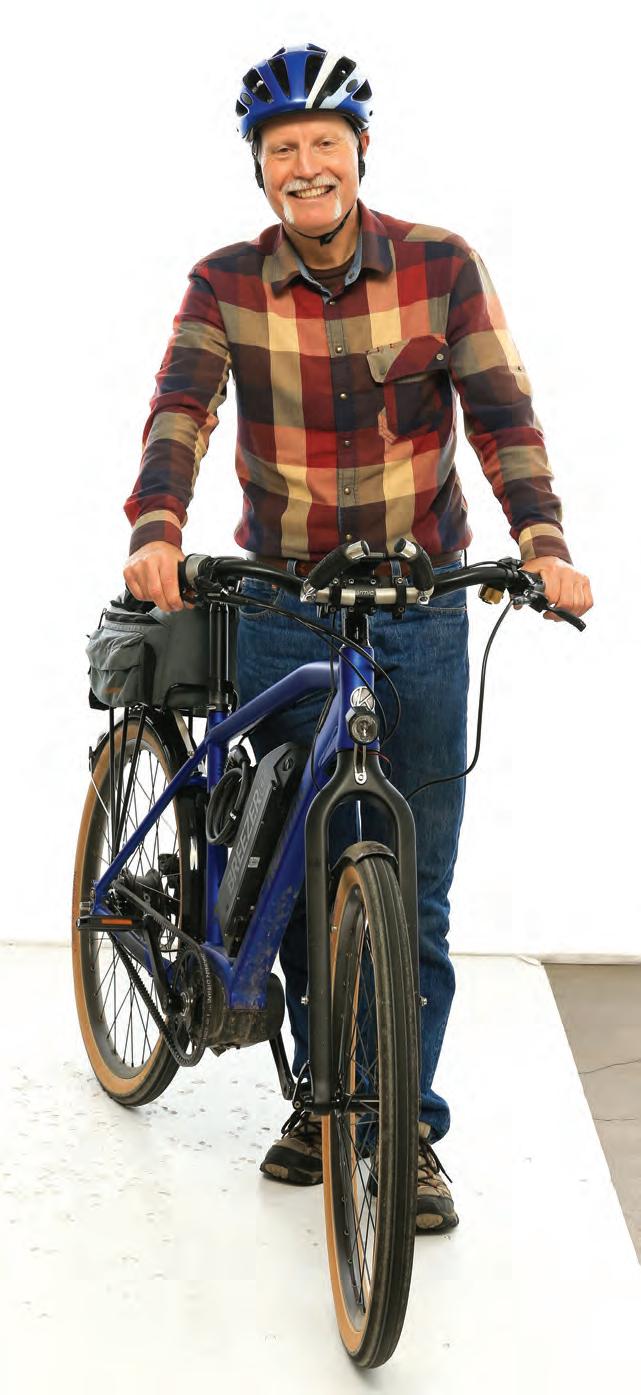
2 minute read
Q&A A local mountain bike innovator.
9 QUESTIONS FOR
Joe Breeze
In 1973, Joe Breeze, a Mill Valley bike enthusiast, bought a “crusty” 1941 Schwinn balloon-tire model for $5 and rode down Mount Tamalpais’s Old Railroad Grade. “It was a blast,” he recalls. On this bike, and other heavy old clunkers, Breeze won Fairfax multiple Repack races — mountain biking’s first organized time-trial downhill contests, held in Fairfax. By 1977, Breeze was welding BIKE DESIGNER together stronger and lighter frames with the intention of sharing this crazy off-road riding mode with others. Those “Breezer” bikes are now considered the first modern mountain bikes. Today, at 65, he’s still designing bicycles and avidly bringing freewheeling fun, fitness and sustainable transportation to pedalers far and wide. BY KIER HOLMES
1How do your early 1980s mountain bikes com-
pare to the Ritchey Mountain Bikes of the same
period by Gary Fisher and Charlie Kelly? My early 1980s Breezers were more rugged. The frames were stronger and the nickel finish tougher, and the parts tended to be more robust. The steering angle was a little steeper; the top tube was longer and generally used with a shorter stem and was considered a more
advanced geometry for the day. 6 Your go-to Marin biking trail? The NorthSouth Greenway along the old Northwestern Pacific Railroad rail corridor. Railroad lines are
mostly flat with few at-grade crossings with motor vehicle traffic, making them safe and convenient for bicycling. From Sausalito to the Civic Center, 8.5 miles of the greenway have been completed with the Alto Tunnel being the last link.
2What have you learned while behind the handlebars? Even before making my Breezers, I learned the simple joy of getting around by bike, the ability to get healthy while getting places and the idea that you get energy by expending energy.
3Favorite all-time bike? The Breezer Finesse, my town bike. It’s fully equipped, ready to go for whatever comes my way. It’s got fenders, lights and a good cargo carrier.
4Why should more people embrace biking? Bicycling offers us the healthiest way of getting around. It’s four or five times faster than walking and uses 20 times less energy per mile than a car. A bike also takes up much less road space. The efficiency of cycling makes bicycling infrastructure the biggest bang for our transportation buck. E-bikes have broadened cycling’s sustainable appeal, especially for people living on hills.
5What is the future of biking in Marin? More safe pathways are being added that connect our towns in healthy ways and are opening up our chances for enjoyable living. 7 Are there any good resources
to learn more about mountain
biking? I’m curator at the Marin Museum of Bicycling, an all-volunteer nonprofit that I founded with longtime friends Otis Guy and Marc Vendetti. Its collection spans 150 years. We share the fascinating, inspiring history of bicycles and the social history of cycling. It’s also home to the world Mountain Bike
Hall of Fame.
8What is your favorite post-ride local hangout? Marin Museum of Bicycling. I enjoy the museum visitors, the monthly speaker series and during the summer, happy hours on Fridays.
9What lessons could we adopt from the bikecentric Netherlands? Right, it’s not as if we need to reinvent the wheel. In Holland, where biking constitutes 30 percent of travel mode share, the people have a safe, convenient and healthful transportation system, separated from the dangers of cars. We can do the same in Marin — and we have better weather. m








